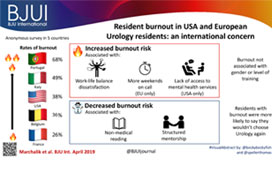
Editorial: The pursuit of purpose: reframing strategies to prevent physician burnout
If there is one virtue that drives surgery residents to toil away in sterile, brightly lit operating rooms for extended hours for the best years of their life, it is the pursuit of purpose. However, these extended hours can also lead to what the WHO has now officially recognized as a medical condition: burnout. In a study in this issue of BJUI, Marchalik et al. [1] use qualitative analysis to elaborate on the prevalence and predictors of burnout among urology residents in the USA and in four European…
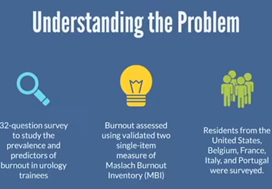
Video: Resident burnout in USA and European urology residents
Resident burnout in USA and European urology residents: an international concern
Abstract
Objective
To describe the prevalence and predictors of burnout in USA and European urology residents, as although the rate of burnout in urologists is high and associated with severe negative sequelae, the extent and predictors of burnout in urology trainees remains poorly understood.
Subjects and methods
An anonymous 32‐question survey of urology trainees across the USA and four European…

Residents’ podcast: Resident burnout
Maria Uloko is a Urology Resident at the University of Minnesota Hospital. In this podcast she discusses the following BJUI Article of the month:
Resident burnout in USA and European urology residents: an international concern
Abstract
Objective
To describe the prevalence and predictors of burnout in USA and European urology residents, as although the rate of burnout in urologists is high and associated with severe negative sequelae, the extent and predictors of burnout in urology…
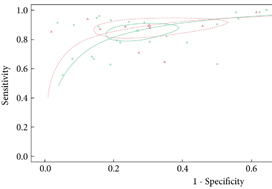
Article of the week: Biparametric vs multiparametric prostate MRI for the detection of PCa in treatment‐naïve patients
Every week, the Editor-in-Chief selects an Article of the Week from the current issue of BJUI. The abstract is reproduced below and you can click on the button to read the full article, which is freely available to all readers for at least 30 days from the time of this post.
In addition to the article itself, there is an editorial written by a prominent member of the urological community, and a video produced by the authors. These are intended to provoke comment and discussion and we invite…

Editorial: Dropping the GAD – just a fad?
It is not without irony that, at the very moment that the UK's National Institute for Health and Care Excellence (NICE) is poised to ratify the recommendation that multiparametric MRI (mpMRI) be introduced into the prostate cancer diagnostic pathway, we are seeking to significantly modify the very intervention on which they are about to provide judgement on [1].
The modification proposed is both compelling and plausible, as it renders the process of imaging the prostate in order to detect and…
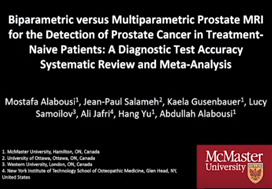
Video: Biparametric vs multiparametric prostate MRI for the detection of PCa in treatment‐naïve patients: a diagnostic test accuracy systematic review and meta‐analysis
Abstract
Objective
To perform a diagnostic test accuracy (DTA) systematic review and meta‐analysis comparing multiparametric (diffusion‐weighted imaging [DWI], T2‐weighted imaging [T2WI], and dynamic contrast‐enhanced [DCE] imaging) magnetic resonance imaging (mpMRI) and biparametric (DWI and T2WI) MRI (bpMRI) in detecting prostate cancer in treatment‐naïve patients.
Methods
The Medical Literature Analysis and Retrieval System Online (MEDLINE) and Excerpta Medica dataBASE…
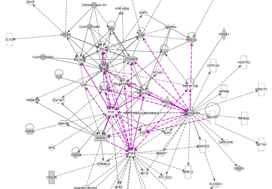
Article of the week: A transcriptomic signature of tertiary Gleason 5 predicts worse clinicopathological outcome
Every week, the Editor-in-Chief selects an Article of the Week from the current issue of BJUI. The abstract is reproduced below and you can click on the button to read the full article, which is freely available to all readers for at least 30 days from the time of this post.
In addition to the article itself, there is an editorial written by a prominent member of the urological community, and a video produced by the authors. These are intended to provoke comment and discussion and we invite…
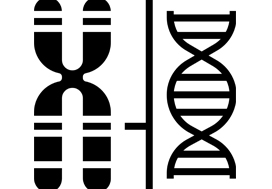
Editorial: Transcriptomic signatures for tertiary pattern 5 in prostate cancer
Significant evidence is now emerging and publications have shown that the molecular characterization of tumours represents an important approach to stratifying patients with prostate cancer into appropriate treatments and their responses, helping to inform the next steps in the care pathway of these patients [1]. Understanding the functional role of the genes included in these signatures also gives an insight into the biology of the disease and how it develops and progresses.
BJUI has published…

Video: A transcriptomic signature of tertiary Gleason 5 predicts worse clinicopathological outcome
A transcriptomic signature of tertiary Gleason 5 predicts worse clinicopathological outcome
by Alberto Martini
Abstract
Objective
To investigate the genomic features of tertiary pattern 5 (TP5) on radical prostatectomy specimens in an effort to explain the poor clinical outcomes associated with this disease subtype.
Patients and methods
Data from 159 men with Gleason Grade Group (GGG) 3 or 4 were considered. All patients had Decipher diagnostic testing with transcript profiles…

